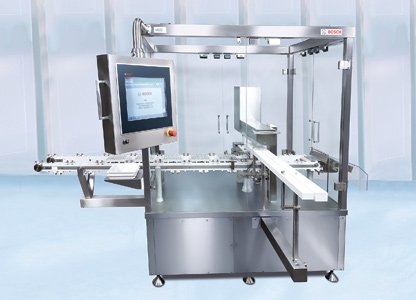
Bosch Packaging Technology, a leading supplier of process and packaging technology, is expanding its line competence in the filling and processing of pre-sterilized syringes. “After successfully establishing our fill-finish port–folio, we will also strengthen our line competence in downstream processes,” says Klaus Ullherr, product manager at Bosch Packaging Technology. “Two steps are required – the rod has to be inserted and the pre-filled syringes have to be inspected. The USD de-nester and the RIL rod insertion and labelling ma–chine are ideal additions to our filling and closing machines, such as the recently launched FXS Combi.” First, machine combinations are already in operation in Europe and Asia.
Gentle removal and transportation
The syringes filled with liquid pharmaceuticals are either manually or automatically placed on the infeed belt of the de-nester in tubs. Using a gripper, the USD removes the syringes in rows and gently transfers them to a horizontal single-lane transport belt. The products remain in a safe and controlled position at all times. Depending on the model, the USD de-nester achieves an output of up to 400 syringes a minute. In combination with the respective inspection machines for particle and cosmetic inspection as well as leak detection, a ZPS buffer system and a RIL rod insertion and labelling machine, lines for middle and high performance can be implemented.
Safety for products, operators and patients
The high-performance machines of the RIL series accomplish exact and gentle rod insertion, and provide for reliable labelling of the syringes. First, the transport belt transfers the syringes to a segment wheel, which ensures that screwing in of the rod is done at optimum conditions in standstill mode. A separate sorting device conveys the rods to a star wheel, which positions the rods and inserts them accurately into the rubber stoppers. The torque control makes sure that the stoppers do not move. In the next step, the segment wheel transfers the syringes to the labelling station, where the labels are applied and checked with a control sensor. A number of additional options are available to read out label data or inspect the quality, readability and coding of the labels.
To ensure optimum product and operator safety as well as high product quality, the RIL models are equipped with a tip closure control, which checks the presence of the protecting cap on the injection needle. All defect syringes are conveyed to a customer-specific reject station via a star wheel. After rod insertion, labelling and inspection, the processed syringes can be additionally equipped with a backstopper on the RIL. Designed for patient safety and ease-of-use, the stopper prevents the plunger head from being pulled out of the syringe and also broadens the finger flange.
First machine combinations in operation
“The downstream equipment is an important part of our line competence for syringes,” says Klaus Ullherr. “The new models meet the requirements in the European, as well as in the growing Asian market. Our specialists have already delivered, installed and put into operation several machines together with our customers.” Further steps for a consequent portfolio expansion are in the planning stage, such as the integration of so-called safety devices for syringes.
Packaging South Asia is the cooperating media partner for drupa 2016 which is scheduled to be held from 31 May to 10 June at Dusseldorf, Germany.







